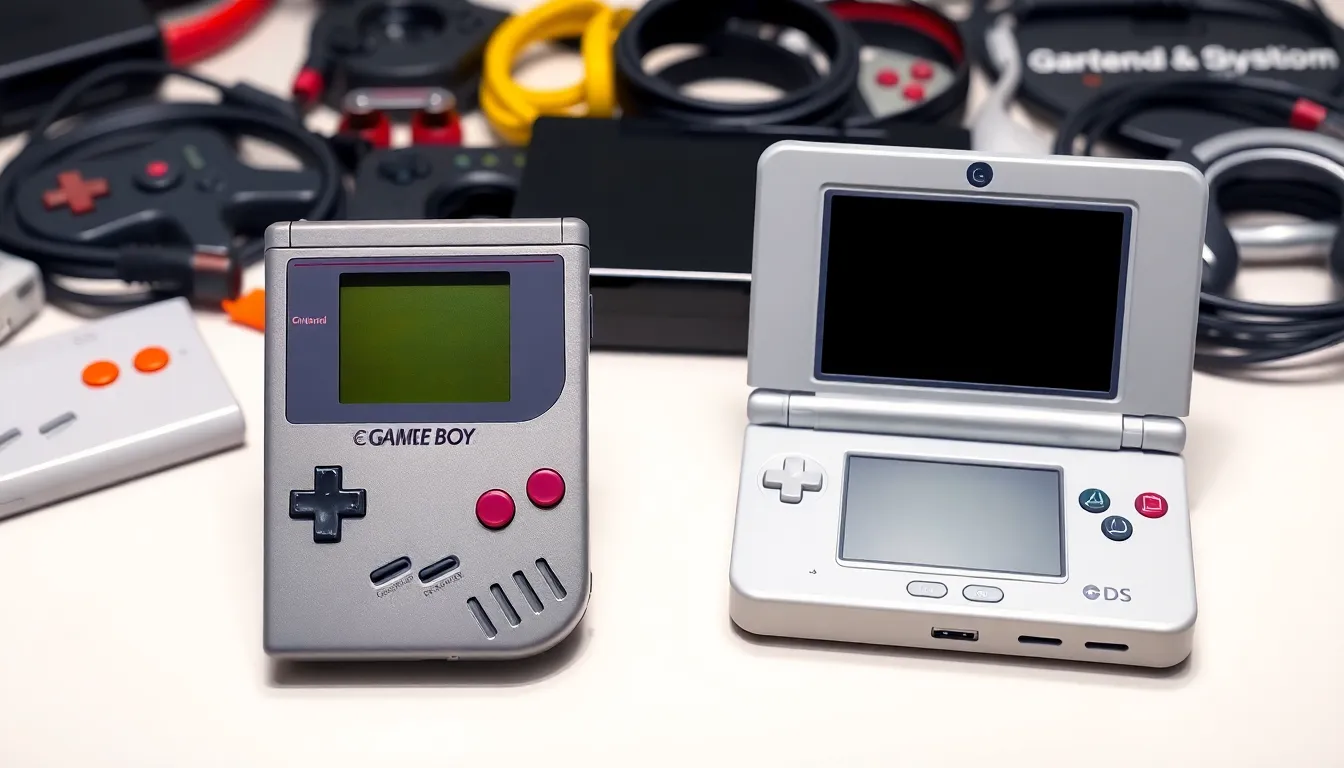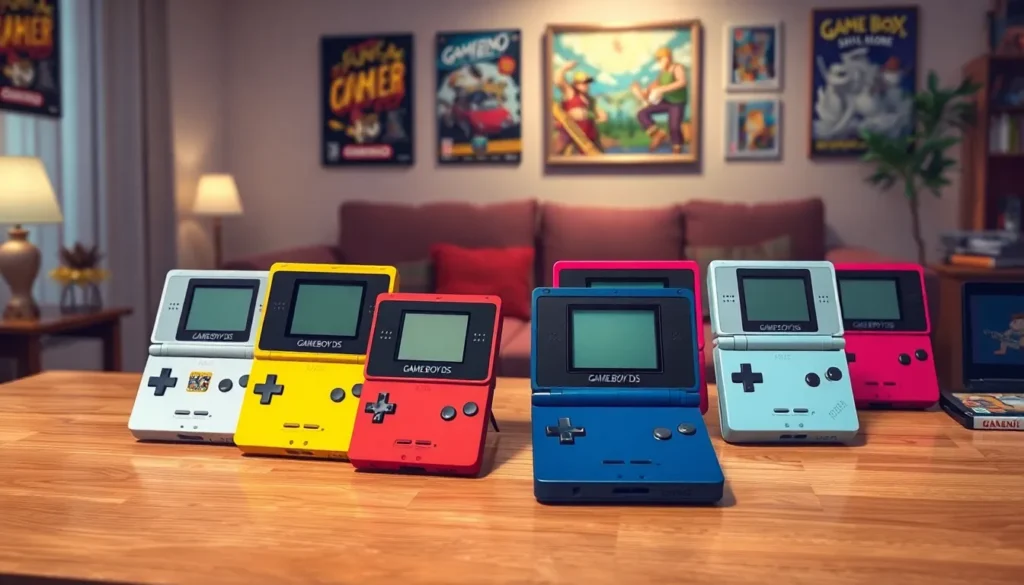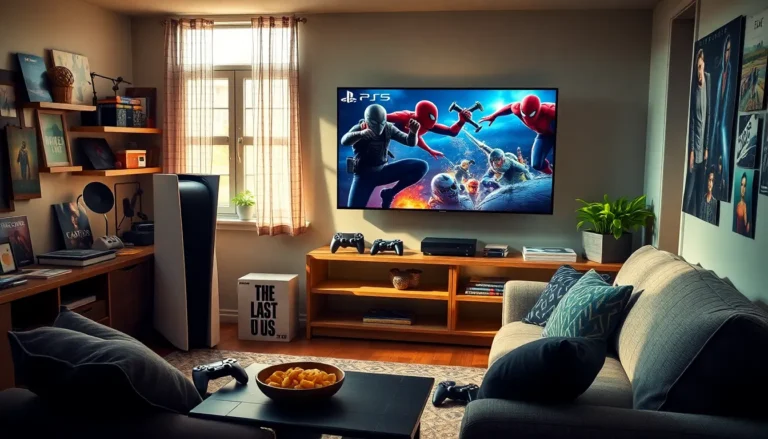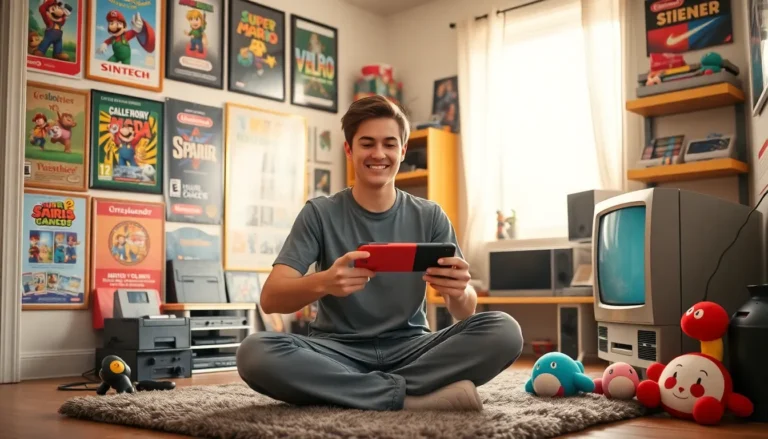In a world where gaming consoles come and go like fashion trends, the Game Boy DS stands out as a timeless classic. It’s not just a handheld device; it’s a portal to nostalgia, a treasure chest filled with pixelated adventures and unforgettable characters. Whether players are battling foes in epic RPGs or racing go-karts with friends, the Game Boy DS delivers a unique experience that keeps them coming back for more.
Table of Contents
ToggleOverview of Game Boy DS
The Game Boy DS stands as a landmark in portable gaming history. Launched in 2004, it introduced dual screens, which enhanced gameplay experiences significantly. One screen displayed the action while the other often provided supplementary information, making games more immersive.
Developed by Nintendo, this console supported various genres, ensuring it catered to diverse gaming preferences. Titles ranged from iconic franchises like Pokémon and Mario to lesser-known yet innovative games. Players enjoyed the versatility and depth these titles offered, contributing to the platform’s acclaim.
Featuring a stylus and touch-screen capabilities, gameplay options expanded beyond traditional button inputs. This unique control scheme encouraged creativity and engagement, drawing in players of all ages. Multiplayer functionality also allowed users to connect with friends, fostering social interactions through gaming. Wireless connectivity supported local multiplayer for up to 16 players.
With a rich library of over 1,300 titles, the Game Boy DS provided endless entertainment. Favorite games like The Legend of Zelda: Phantom Hourglass and Animal Crossing: Wild World captivated audiences. Gamers appreciated the repeat value and replayability these titles provided.
Investors and collectors view the Game Boy DS as a staple in gaming culture. Units remain popular on the second-hand market, often priced between $40 and $150, depending on condition and included accessories. Nostalgia reinforces its demand, ensuring a legacy that endures.
The Game Boy DS not only shaped the gaming landscape but also established a foundation for future handheld consoles. Its innovative features and extensive game library solidified its status as a beloved classic.
Evolution of Handheld Consoles

Handheld consoles have significantly transformed since their inception. Their evolution reflects advancements in technology and shifts in player preferences.
The Original Game Boy
Released in 1989, the original Game Boy marked the beginning of portable gaming’s popularity. It featured an 8-bit display, a simple design, and an iconic grey casing. Players enjoyed classics like Tetris and Super Mario Land, which showcased the device’s capabilities. During its lifespan, the Game Boy sold over 118 million units worldwide, establishing Nintendo as a leader in the handheld market. Its ease of use and battery life drew casual gamers, while its library attracted dedicated enthusiasts.
The Transition to DS Technology
The launch of the Nintendo DS in 2004 represented a major shift in handheld technology. Dual screens allowed for immersive gameplay experiences, providing innovative ways to interact with games. Players could utilize touch controls with a stylus, enhancing engagement in titles like Nintendogs and Brain Age. Advanced graphics supported a diverse range of game genres, from action to puzzle-solving. The DS’s backward compatibility with Game Boy Advance titles ensured a broad appeal, attracting both new and existing players. This transition set new standards in gaming, as developers embraced the unique features of the DS, paving the way for future devices.
Features of Game Boy DS
The Game Boy DS stands out in portable gaming with its unique features that enhance user experience.
Dual Screens and Touch Functionality
Dual screens revolutionized gameplay by presenting action alongside supporting information. The top screen displays vivid graphics while the bottom screen incorporates touch functionality. Players interact directly with the action using a stylus or fingers, adding a tactile dimension to gaming. This innovative design increased engagement across various genres, encouraging creativity in puzzle games and strategy titles. From classic adventures to modern narratives, the dual-screen setup catered to diverse interests, leading to a richer gaming experience. This feature, launched in 2004, not only captivated players but also established new standards for future handheld systems.
Backward Compatibility with Game Boy Games
Backward compatibility allows players to enjoy their favorite Game Boy titles on the Game Boy DS. This feature ensures players can access a vast library of over 1,000 classic games, expanding the console’s entertainment value. Compatible titles range from iconic franchises to nostalgic favorites. The seamless transition allows for easy access to memories while discovering new gameplay experiences. Players benefit from enhanced graphics and longer battery life when revisiting these classic games. This commitment to preserving gaming history reinforces the Game Boy DS’s role in bridging generations of gamers.
Popular Games on Game Boy DS
The Game Boy DS features an extensive library of games that captures the imagination of countless players. This collection showcases a mix of iconic titles and notable franchises that defined the gaming experience.
Iconic Titles that Defined the Platform
“New Super Mario Bros.” represents a quintessential gaming experience, bringing familiar platforming elements with modern twists. “The Legend of Zelda: Phantom Hourglass” offers innovative touch controls alongside classic adventure mechanics. A standout title, “Pokémon Diamond and Pearl,” revolutionized the Pokémon franchise with enhanced graphics and features. “Animal Crossing: Wild World” introduces a life simulation genre that appeals to a wide audience through its open-world gameplay. Each title adds value to the Game Boy DS, ensuring diverse entertainment for players.
Notable Franchises and Their Impact
Franchises like Pokémon and Mario exemplify the impact the Game Boy DS had on the gaming landscape. Pokémon became a cultural phenomenon, generating enthusiasm through trading and battling mechanics. Mario continued to showcase Nintendo’s ability to innovate within platforming genres, drawing in both new and veteran gamers. The thrill of “Final Fantasy” and its storytelling captivated RPG fans, while titles like “Professor Layton” introduced puzzle-solving in engaging narratives. Each franchise not only solidifies the Game Boy DS’s reputation but also influences future games and handheld consoles.
The Legacy of Game Boy DS
Game Boy DS represents a monumental chapter in gaming history, cementing its place as a timeless classic. Launched in 2004 by Nintendo, the handheld console reshaped the portable gaming landscape with innovative features. Dual screens delivered engaging gameplay, allowing players to experience dynamic action while accessing supplementary information. Engaging visuals on the top screen combined with touch functionality on the bottom screen encouraged creativity across numerous genres.
Nostalgia plays a vital role in the enduring appeal of Game Boy DS. With a library exceeding 1,300 titles, players connect with beloved characters and unforgettable adventures. Iconic franchises like Pokémon, Mario, and The Legend of Zelda elevated the console’s reputation, influencing future game development. Each title enriched the overall gaming experience, making the Game Boy DS a highly sought-after device for both casual and dedicated gamers.
Social interaction remains integral to its legacy. The multiplayer capabilities allowed up to 16 players to connect, fostering friendships and competitive spirit. Engaging in racing games or epic RPG battles became memorable moments shared among friends. Such features enhanced the handheld’s popularity and ensured lasting relevance in gaming culture.
Investors and collectors value Game Boy DS units significantly, reflecting their status in the market. Prices often fall between $40 and $150 for second-hand devices, demonstrating consistent demand. Backward compatibility with over 1,000 classic Game Boy titles allows players to revisit nostalgic favorites, further solidifying the console’s place in gaming history. Overall, Game Boy DS bridged generations and set new standards for handheld gaming, making it a cornerstone of the industry.
The Game Boy DS stands as a pivotal milestone in gaming history. Its innovative design and extensive game library created a unique experience that continues to resonate with players. The blend of nostalgia and advanced features established it as a beloved console, bridging generations of gamers.
This handheld device not only set new standards for portable gaming but also fostered social interactions through its multiplayer capabilities. As it remains a sought-after item for collectors and casual gamers alike, the Game Boy DS’s legacy endures, ensuring its place in the hearts of many.






